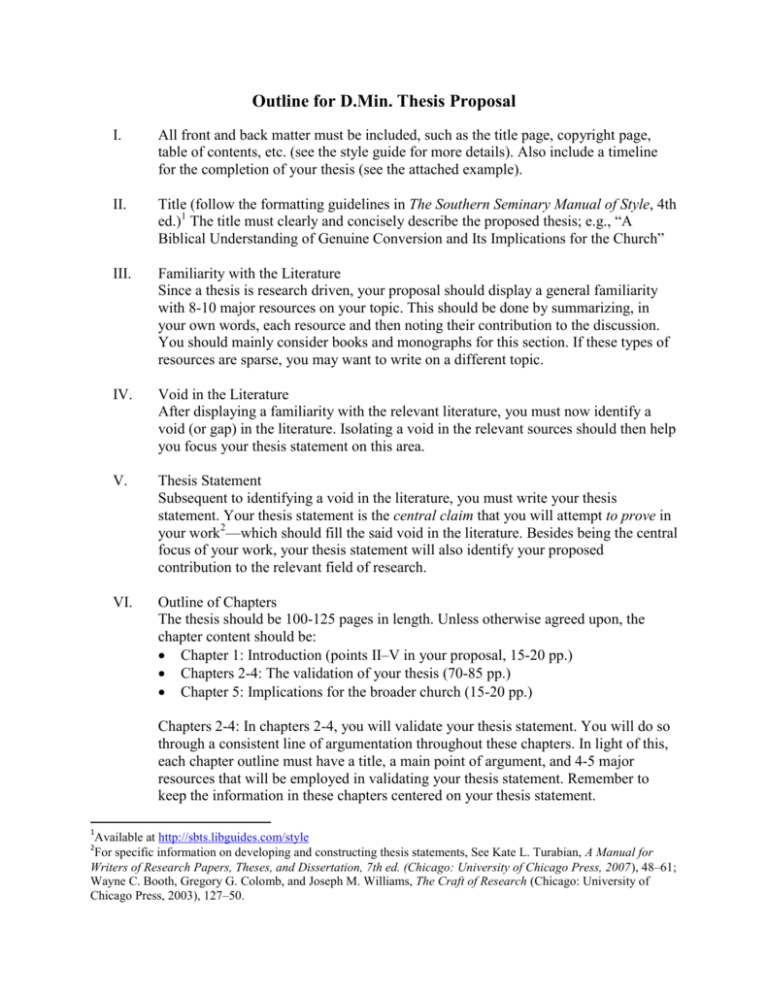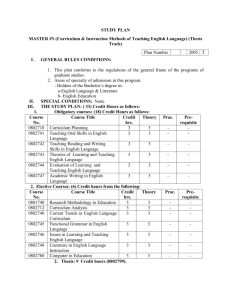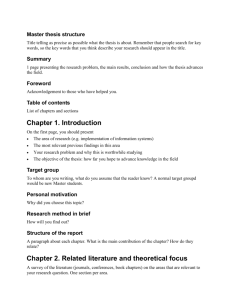Outline for D.Min. Thesis Proposal
advertisement

Outline for D.Min. Thesis Proposal I. All front and back matter must be included, such as the title page, copyright page, table of contents, etc. (see the style guide for more details). Also include a timeline for the completion of your thesis (see the attached example). II. Title (follow the formatting guidelines in The Southern Seminary Manual of Style, 4th ed.)1 The title must clearly and concisely describe the proposed thesis; e.g., “A Biblical Understanding of Genuine Conversion and Its Implications for the Church” III. Familiarity with the Literature Since a thesis is research driven, your proposal should display a general familiarity with 8-10 major resources on your topic. This should be done by summarizing, in your own words, each resource and then noting their contribution to the discussion. You should mainly consider books and monographs for this section. If these types of resources are sparse, you may want to write on a different topic. IV. Void in the Literature After displaying a familiarity with the relevant literature, you must now identify a void (or gap) in the literature. Isolating a void in the relevant sources should then help you focus your thesis statement on this area. V. Thesis Statement Subsequent to identifying a void in the literature, you must write your thesis statement. Your thesis statement is the central claim that you will attempt to prove in your work2—which should fill the said void in the literature. Besides being the central focus of your work, your thesis statement will also identify your proposed contribution to the relevant field of research. VI. Outline of Chapters The thesis should be 100-125 pages in length. Unless otherwise agreed upon, the chapter content should be: Chapter 1: Introduction (points II–V in your proposal, 15-20 pp.) Chapters 2-4: The validation of your thesis (70-85 pp.) Chapter 5: Implications for the broader church (15-20 pp.) Chapters 2-4: In chapters 2-4, you will validate your thesis statement. You will do so through a consistent line of argumentation throughout these chapters. In light of this, each chapter outline must have a title, a main point of argument, and 4-5 major resources that will be employed in validating your thesis statement. Remember to keep the information in these chapters centered on your thesis statement. 1 Available at http://sbts.libguides.com/style For specific information on developing and constructing thesis statements, See Kate L. Turabian, A Manual for Writers of Research Papers, Theses, and Dissertation, 7th ed. (Chicago: University of Chicago Press, 2007), 48–61; Wayne C. Booth, Gregory G. Colomb, and Joseph M. Williams, The Craft of Research (Chicago: University of Chicago Press, 2003), 127–50. 2 Chapter 5: After validating your thesis statement, this chapter will discuss the implications of your thesis for the broader (not just local) church. So if your thesis pertains to the genuine conversion of believers, you should discuss the implications of this perspective for the church. In your outline, list and briefly discuss (in 1-2 paragraphs) each major implication. Be sure that your implications are directly tied to your thesis statement. VII. Annotated Bibliography (see the more detailed, attached instructions) Briefly summarize 20-25 initial resources, such as books, monographs, and journal articles, which you plan to use in your thesis. Strive to use resources that are both in line with your own perspective and also display familiarity with diverse viewpoints pertaining to your topic. PREPARING ANNOTATED BIBLIOGRAPHIES WHAT IS AN ANNOTATED BIBLIOGRAPHY? An annotated bibliography is a list of citations to books, articles, and documents. Each citation is followed by a brief (usually about 100-150 words) descriptive and evaluative paragraph, the annotation. The purpose of the annotation is to inform the reader of the relevance, accuracy, and quality of the sources cited. ANNOTATIONS VS. ABSTRACTS Abstracts are the purely descriptive summaries often found at the beginning of scholarly journal articles or in periodical indexes. Annotations are descriptive and critical; they expose the author's point of view, clarity and appropriateness of expression, and authority. THE PROCESS Creating an annotated bibliography calls for the application of a variety of intellectual skills: concise exposition, succinct analysis, and informed library research. First, locate and record citations to books, periodicals, and documents that may contain useful information and ideas on your topic. Briefly examine and review the actual items. Then choose those works that provide a variety of perspectives on your topic. Cite the book, article, or document using the appropriate style. Write a concise annotation that summarizes the central theme and scope of the book or article. Include one or more sentences that (a) evaluate the authority or background of the author, (b) comment on the intended audience, (c) compare or contrast this work with another you have cited, or (d) explain how this work illuminates your bibliography topic. CRITICALLY APPRAISING THE BOOK, ARTICLE, OR DOCUMENT For guidance in critically appraising and analyzing the sources for your bibliography, see How to Critically Analyze Information Sources (http://www.library.cornell.edu/olinuris/ref/research/skill26.htm) CHOOSING THE CORRECT FORMAT FOR THE CITATIONS Make sure to follow The Southern Seminary Manual of Style, 4th ed., for this assignment. SAMPLE ANNOTATED BIBLIOGRAPHY ENTRY FOR A JOURNAL ARTICLE Waite, L. J., Goldschneider, F. K., & Witsberger, C. “Nonfamily Living and the Erosion of Traditional Family Orientations Among Young Adults.” American Sociological Review 51 (4) (1986), 541-554. The authors, researchers at the Rand Corporation and Brown University, use data from the National Longitudinal Surveys of Young Women and Young Men to test their hypothesis that nonfamily living by young adults alters their attitudes, values, plans, and expectations, moving them away from their belief in traditional sex roles. They find their hypothesis strongly supported in young females, while the effects were fewer in studies of young males. Increasing the time away from parents before marrying increased individualism, self-sufficiency, and changes in attitudes about families. In contrast, an earlier study by Williams cited below shows no significant gender differences in sex role attitudes as a result of nonfamily living. Adapted with permission from Cornell University: Olin Library Reference / Research & Learning Services / Cornell University Library /Ithaca, NY, USA http://www.library.cornell.edu/olinuris/ref/research/skill28.htm#sample Below you will find an example of an abbreviated task list to accomplish the writing of a single chapter for the DMin/DEdMin project. This is a realistic time table for most who are heavily engaged in ministry responsibilities and is reflective of a minimum amount of time required. CHAPTER 2 2 2 2 2 2 2 2 2 2 2 2 2 2 2 2 2 2 2 2 2 TASK Determine primary texts to exegete Study texts as a whole Write chapter thesis statement Exegete text 1 with commentary use, etc Write section based on text 1 Exegete text 2 with commentary use, etc Write section based on text 2 Exegete text 3 with commentary use, etc Write section based on text 3 Exegete text 4 with commentary use, etc Write section based on text 4 Edit chapter 2 Submit chapter 2 to two editors (one for content/one for grammar, style, argumentation, fluency, etc) Retrieve chapter 2 edits from editors Revise based on editors feedback Have editors review changes and provide feedback Make any needed corrections SUBMIT CHAPTER 2 TO SUPERVISOR Receive review and feedback from supervisor Make all necessary changes to chapter 2 Submit “final” version of chapter 2 to supervisor for approval ESTIMATED TIME 10 hrs 10 hrs 2 hrs 5 hrs 8 hrs 5 hrs 8 hrs 5 hrs 8 hrs 5 hrs 8 hrs 8 hrs 1 hrs TARGET DATE June 1, 2012 June 8, 2012 June 9, 2012 June 13, 2012 June 17, 2012 June 20, 2012 June 23, 2012 June 27, 2012 June 30, 2012 July 4, 2012 July 8, 2012 July 9, 2012 July 10, 2012 1 hrs 10 hrs 1 hrs 3 hrs 1 hrs July 17, 2012 July 20, 2012 July 21-23, 2012 July 24, 2012 July 25, 2012 August 10, 2012 August 15, 2012 August 20, 2012 80 days 10 hrs 1 hrs 110 hrs COMPLETION







